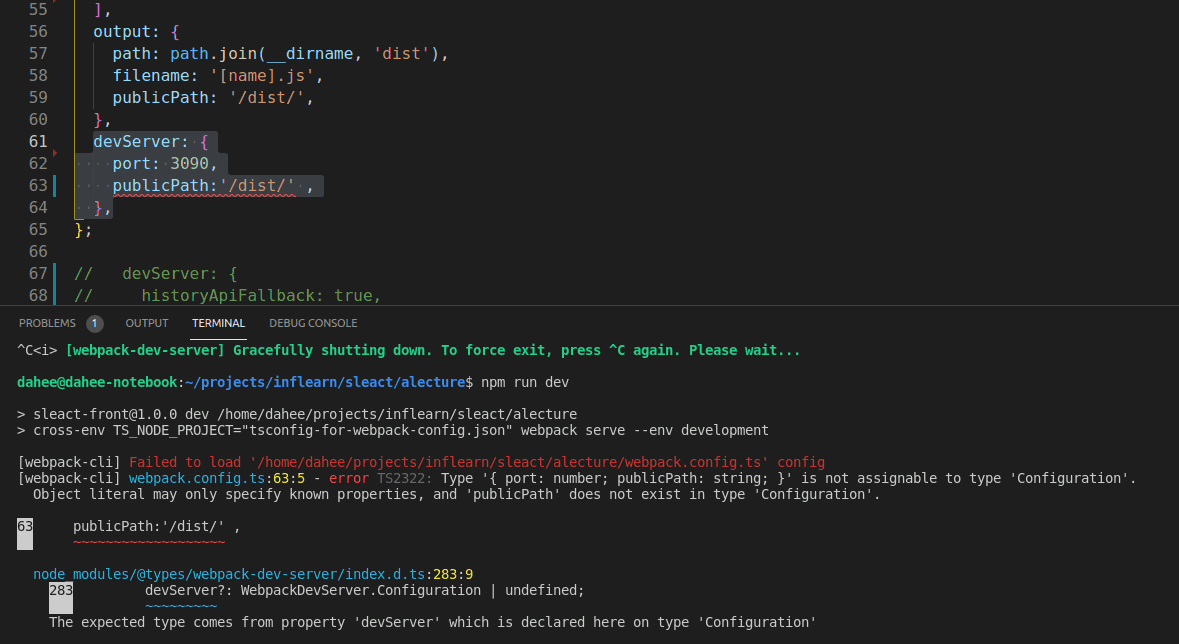Webpack-Cli Failed To Load Config
I. Understanding webpack-cli
Webpack-cli is a command line interface tool that allows developers to configure and run Webpack, a popular module bundler for JavaScript applications. With webpack-cli, developers can easily manage and control their webpack configurations from the command line interface.
II. Common Issue: “Failed to load config” error
When encountering the “Failed to load config” error, webpack-cli is unable to locate or load the specified configuration file. This error message is typically displayed when running webpack commands such as “webpack –config” and indicates a problem in accessing the configuration file.
Possible causes of this error include incorrect webpack-cli installation, incorrect configuration file path, invalid or malformed configuration file, dependency mismatch or version conflicts, issues with the webpack.config.js file, and compatibility problems with webpack-cli versions.
III. Incorrect webpack-cli installation
Improper installation of webpack-cli can result in configuration issues. To rectify this problem, follow these steps:
1. Ensure that Node.js and npm are installed on your system.
2. Open the terminal or command prompt and run the following command to install webpack-cli globally:
`npm install -g webpack-cli`
3. Verify the installation by running `webpack-cli –version` command.
IV. Incorrect configuration file path
The correct path for the configuration file is crucial for webpack-cli to locate and load it. Here are some troubleshooting steps to ensure the correct file path:
1. Double-check the file path specified in the command or configuration file.
2. Verify that the file is present in the specified location.
3. Check for any spelling mistakes or incorrect file extensions.
4. Try using an absolute path instead of a relative path to eliminate any path-related issues.
V. Invalid or malformed configuration file
An invalid or malformed configuration file can prevent webpack-cli from loading the config correctly. To identify and correct configuration errors:
1. Verify the syntax and structure of the configuration file, typically `webpack.config.js`.
2. Use webpack’s official documentation and guides to ensure correct configurations.
3. Validate the configuration file using online tools like webpack-validator to catch any errors or typos.
VI. Dependencies mismatch or version conflicts
Conflicting dependencies can cause webpack-cli to fail loading the config. To resolve dependency or version conflicts:
1. Update both webpack and webpack-cli to the latest versions to ensure compatibility.
2. Check for conflicting or duplicate packages in your project’s package.json file.
3. Use npm or yarn commands to update or resolve any conflicting dependencies.
VII. Issues with the webpack.config.js file
The webpack.config.js file plays a crucial role in configuring webpack. Common mistakes in the configuration file and their fixes include:
1. Missing or incomplete module.exports object: Ensure that the configuration file exports a valid object that defines the required webpack configurations.
2. Incompatible or missing loaders and plugins: Verify that the loaders and plugins used in the configuration file are installed and correctly configured.
3. Syntax errors or typos: Review the configuration file for any syntax errors or misspelled properties, and correct them accordingly.
VIII. Compatibility issues with webpack-cli versions
Using an incompatible version of webpack-cli can result in configuration errors. To ensure compatibility:
1. Check the webpack-cli documentation or official website for any version-specific requirements or migration guides.
2. Update or downgrade the webpack-cli version to match the requirements of your project.
3. Validate compatibility by referring to the official webpack-cli and webpack release notes.
IX. Seeking help and support
When facing webpack-cli failed to load config issues, there are several resources available for finding solutions and seeking assistance:
1. Official webpack documentation: The official webpack documentation provides comprehensive guides, tutorials, and troubleshooting steps.
2. Online forums and communities: Join online communities such as Stack Overflow or webpack’s official Slack channel to seek advice from experienced developers.
3. GitHub issues: Browse through Github issues for both webpack-cli and webpack to find solutions to common problems and report any new issues you encounter.
4. Contacting webpack-cli developers: Consider reaching out directly to webpack-cli developers via their official channels for personalized support.
In conclusion, the “webpack-cli failed to load config” error can occur due to various reasons, and understanding the causes and solutions provided in this article will help you effectively troubleshoot and resolve the issue. Remember to consult the official documentation and community resources for further guidance and support.
Error : Cannot Find Module Webpack-Cli/Bin/Config-Yargs | How To Fix It? – 2021
Keywords searched by users: webpack-cli failed to load config Webpack –config, Cannot find module ‘webpack-cli/bin/config-yargs, Unable to load ‘@webpack-cli/serve’ command, Webpack-dev-server, Webpack, Unable load webpack –config ts, Install webpack, Webpack-cli TypeError: Cannot read property getarguments of undefined
Categories: Top 70 Webpack-Cli Failed To Load Config
See more here: nhanvietluanvan.com
Webpack –Config
The configuration file, often named `webpack.config.js`, serves as the entry point for Webpack. It provides a way to define various settings and options that control how Webpack handles the bundling process. By default, Webpack will look for a file with this name in the root directory of the project, but a different path can be specified using the `–config` command line option.
The `webpack.config.js` file uses the JavaScript language to export a configuration object. This object contains numerous properties that determine how Webpack behaves. Here are some of the most common properties that can be defined in the configuration file:
1. `entry`: This property specifies the entry point of the application, which is the starting point for Webpack to traverse the dependency graph and bundle all the necessary files. It can be a single file or an array of files.
2. `output`: This property defines where the bundled files should be saved and how they should be named. It provides options such as the output directory, the filename pattern, and the public URL for loading the files in the browser.
3. `module`: This property allows developers to define rules for how Webpack should handle different types of files. For example, rules can be set to use specific loaders for processing CSS files, transpiling JavaScript with Babel, or optimizing images.
4. `plugins`: Webpack plugins are powerful tools that can be used to extend and enhance the bundling process. The `plugins` property allows developers to specify which plugins should be used and how they should be configured. Examples of plugins include code minification, chunk splitting, and HTML generation.
5. `resolve`: This property controls how Webpack resolves module dependencies. It can be used to specify additional directories to search for modules, define alias mappings for module paths, or enable the resolution of certain file extensions.
In addition to these properties, the `webpack.config.js` file can be extended with various other settings and options to meet the specific requirements of a project. These can range from advanced optimization techniques and performance tweaks to environment-specific configurations and customizing the development or production mode of Webpack.
To use a custom configuration file with Webpack, the `–config` command line option can be used. For example, if the configuration file is named `my-webpack-config.js` and is located in a different directory, the following command can be used to specify the path:
“`
webpack –config path/to/my-webpack-config.js
“`
This allows developers to have multiple configuration files for different environments or use cases, making it easier to manage and maintain complex projects.
FAQs:
Q: What is the purpose of the `webpack.config.js` file?
A: The `webpack.config.js` file serves as the entry point for Webpack and allows developers to customize the behavior of the bundler by defining various settings and options.
Q: Where is the `webpack.config.js` file located?
A: By default, Webpack looks for the `webpack.config.js` file in the root directory of the project. However, a different path can be specified using the `–config` command line option.
Q: How can I specify a custom configuration file with Webpack?
A: To use a different configuration file, use the `–config` command line option followed by the path to the configuration file. For example: `webpack –config path/to/config.js`.
Q: What are some common properties in the `webpack.config.js` file?
A: Some common properties include `entry`, `output`, `module`, `plugins`, and `resolve`. These properties control aspects such as the entry point of the application, the output file location and naming, module handling rules, the use of plugins, and module resolution.
Q: Can I have multiple configuration files for different environments?
A: Yes, Webpack allows for the use of multiple configuration files. This is helpful when customizing the bundling process for different environments or use cases.
In conclusion, the `webpack.config.js` file is a crucial aspect of using Webpack effectively. It allows developers to define various settings and options to customize the bundling process to suit their project’s specific needs. By utilizing this configuration file, developers can fine-tune how Webpack behaves, efficiently bundle their JavaScript files and assets, and optimize their applications for production.
Cannot Find Module ‘Webpack-Cli/Bin/Config-Yargs
If you have ever encountered the error “Cannot find module ‘webpack-cli/bin/config-yargs'” while working with webpack, you are not alone. Many developers have run into this issue, and it can be frustrating when you are trying to build and bundle your JavaScript projects. In this article, we will delve into the details of this error, its possible causes, and provide some troubleshooting tips to help you resolve it.
Understanding the Error:
The error message “Cannot find module ‘webpack-cli/bin/config-yargs'” is a common issue faced by developers using webpack, a popular module bundler for JavaScript. This error occurs when webpack is unable to locate the necessary module required to execute the webpack-cli command.
Although this error may seem daunting, it often has a straightforward solution. By understanding its causes, you can save yourself time and effort in troubleshooting.
Possible Causes of the Error:
1. Outdated webpack-cli: One possible cause of this error is an outdated or incompatible version of webpack-cli. Webpack-cli is an essential component that enables you to run webpack commands from the command line interface (CLI). If you recently updated your webpack or webpack-cli package, ensure that both are compatible with each other.
2. Missing or incorrect installation: Another common cause is a missing or incorrect installation of webpack-cli. This can occur if you have not installed webpack-cli globally or if it was not included as a project dependency.
3. Version conflicts: Conflicts between different versions of webpack or other dependencies can also trigger this error. It is crucial to ensure that all packages are compatible and do not have conflicting versions.
Troubleshooting Tips:
Now that we have explored the possible causes, let’s dive into some troubleshooting tips to resolve the “Cannot find module ‘webpack-cli/bin/config-yargs'” error:
1. Check webpack-cli installation: Begin by verifying that webpack-cli is installed correctly. Run the command `npm ls webpack-cli` to check the installed version. If webpack-cli is not listed, install it either globally (`npm install -g webpack-cli`) or as a project dependency (`npm install –save-dev webpack-cli`).
2. Update webpack-cli: If you already have webpack-cli installed, ensure it is up to date. Run `npm outdated webpack-cli` to check for any updates. If a newer version is available, update webpack-cli using the command `npm update webpack-cli`.
3. Check webpack and webpack-cli compatibility: Confirm that webpack and webpack-cli are compatible versions. In your project’s package.json, check the dependencies section to ensure both packages have the same version number. If there is a mismatch, update both packages to the same version.
4. Clear npm cache: Sometimes, the npm cache can cause conflicts, leading to errors like this. Clear your npm cache by running the command `npm cache clean –force`. Then try running webpack again to see if the error persists.
5. Reinstall webpack and webpack-cli dependencies: If none of the above steps resolve the issue, consider reinstalling the required dependencies for webpack and webpack-cli. Delete the “node_modules” folder in your project directory and run `npm install` to reinstall all packages.
FAQs:
Q1. Can I use webpack without webpack-cli?
A1. No, webpack-cli is essential for running webpack commands from the command line interface. It provides a range of functionalities and options required for managing webpack configurations and bundling.
Q2. Why is a global installation of webpack-cli necessary?
A2. While it is possible to install webpack-cli locally, a global installation allows you to use webpack commands across multiple projects without the need to install it separately for each project.
Q3. Are there any alternative module bundlers to webpack?
A3. Yes, several alternatives to webpack exist, such as Parcel, Rollup, and Browserify. Each has its own unique features and strengths, so choosing the right one depends on your specific project requirements.
Q4. What should I do if none of the troubleshooting steps solve the issue?
A4. If you have exhausted all troubleshooting steps and the error persists, it is recommended to seek assistance from the webpack community or online developer forums. Provide details about your project setup, dependencies, and any relevant error messages for better guidance.
In conclusion, encountering the “Cannot find module ‘webpack-cli/bin/config-yargs'” error can be frustrating, but with a systematic approach, it can usually be resolved. By understanding the possible causes and following the troubleshooting tips mentioned in this article, you can overcome this error and continue bundling your JavaScript projects using webpack.
Images related to the topic webpack-cli failed to load config

Found 49 images related to webpack-cli failed to load config theme
![reactjs - docker build failed with [webpack-cli] Failed to load webpack.prod.js - Stack Overflow Reactjs - Docker Build Failed With [Webpack-Cli] Failed To Load Webpack.Prod.Js - Stack Overflow](https://i.stack.imgur.com/sDxq8.png)












Article link: webpack-cli failed to load config.
Learn more about the topic webpack-cli failed to load config.
- webpack-cli failed to load webpack.config.js and couldn’t find …
- [webpack-cli] Failed to load ‘client\webpack.config.js’ config
- Error in node.js webpack-cli failed to load config, typeError
- IDE “failed to load” webpack config that exports function taking …
- Cannot find module ‘webpack’ error [Solved] – bobbyhadz
See more: nhanvietluanvan.com/luat-hoc